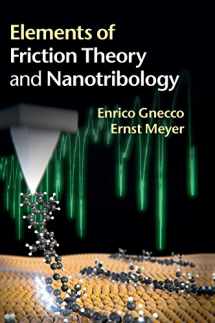
Elements of Friction Theory and Nanotribology
ISBN-13:
9781107006232
ISBN-10:
1107006236
Edition:
Illustrated
Author:
Enrico Gnecco, Ernst Meyer
Publication date:
2015
Publisher:
Cambridge University Press
Format:
Hardcover
318 pages
Category:
Mechanical
,
Solid-State Physics
,
Physics
,
Engineering
FREE US shipping
on ALL non-marketplace orders
Rent
35 days
Due Jun 13, 2024
35 days
from $97.06
USD
Marketplace
from $156.77
USD
Marketplace offers
Seller
Condition
Note
Seller
Condition
Used - Good
Book details
ISBN-13:
9781107006232
ISBN-10:
1107006236
Edition:
Illustrated
Author:
Enrico Gnecco, Ernst Meyer
Publication date:
2015
Publisher:
Cambridge University Press
Format:
Hardcover
318 pages
Category:
Mechanical
,
Solid-State Physics
,
Physics
,
Engineering
Summary
Elements of Friction Theory and Nanotribology (ISBN-13: 9781107006232 and ISBN-10: 1107006236), written by authors
Enrico Gnecco, Ernst Meyer, was published by Cambridge University Press in 2015.
With an overall rating of 4.2 stars, it's a notable title among other
Mechanical
(Solid-State Physics, Physics, Engineering) books. You can easily purchase or rent Elements of Friction Theory and Nanotribology (Hardcover) from BooksRun,
along with many other new and used
Mechanical
books
and textbooks.
And, if you're looking to sell your copy, our current buyback offer is $0.3.
Description
Combining the classical theories of contact mechanics and lubrication with the study of friction on the nanometer range, this multi-scale book for researchers and students alike guides the reader deftly through the mechanisms governing friction processes, based on state-of-the-art models and experimental results. The first book in the field to incorporate recent research on nanotribology with classical theories of contact mechanics, this unique text explores atomic scale scratches, non-contact friction and fishing of molecular nanowires as observed in the lab. Beginning with simple key concepts, the reader is guided through progressively more complex topics, such as contact of self-affine surfaces and nanomanipulation, in a consistent style, encompassing both macroscopic and atomistic descriptions of friction, and using unified notations to enable use by physicists and engineers across the scientific community.


We would LOVE it if you could help us and other readers by reviewing the book
Book review

Congratulations! We have received your book review.
{user}
{createdAt}
by {truncated_author}


